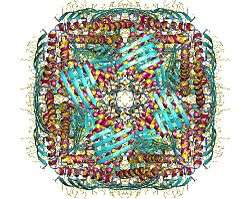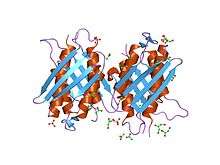Imidazoleglycerol-phosphate dehydratase
| imidazoleglycerol-phosphate dehydratase | |||||||||
|---|---|---|---|---|---|---|---|---|---|
 | |||||||||
| Identifiers | |||||||||
| EC number | 4.2.1.19 | ||||||||
| CAS number | 9024-35-5 | ||||||||
| Databases | |||||||||
| IntEnz | IntEnz view | ||||||||
| BRENDA | BRENDA entry | ||||||||
| ExPASy | NiceZyme view | ||||||||
| KEGG | KEGG entry | ||||||||
| MetaCyc | metabolic pathway | ||||||||
| PRIAM | profile | ||||||||
| PDB structures | RCSB PDB PDBe PDBsum | ||||||||
| Gene Ontology | AmiGO / QuickGO | ||||||||
| |||||||||
| Imidazoleglycerol-phosphate dehydratase | |||||||||
|---|---|---|---|---|---|---|---|---|---|
 crystal structure of imidazole glycerol phosphate dehydratase | |||||||||
| Identifiers | |||||||||
| Symbol | IGPD | ||||||||
| Pfam | PF00475 | ||||||||
| Pfam clan | CL0329 | ||||||||
| InterPro | IPR000807 | ||||||||
| PROSITE | PDOC00738 | ||||||||
| SCOP | 1rhy | ||||||||
| SUPERFAMILY | 1rhy | ||||||||
| |||||||||
In enzymology, an imidazoleglycerol-phosphate dehydratase (EC 4.2.1.19) is an enzyme that catalyzes the chemical reaction
- D-erythro-1-(imidazol-4-yl)glycerol 3-phosphate 3-(imidazol-4-yl)-2-oxopropyl phosphate + H2O
Hence, this enzyme has one substrate, D-erythro-1-(imidazol-4-yl)glycerol 3-phosphate, and two products, 3-(imidazol-4-yl)-2-oxopropyl phosphate and H2O. This reaction is the sixth step in the biosynthesis of histidine in bacteria, fungi and plants.
This enzyme belongs to the family of lyases, specifically the hydro-lyases, which cleave carbon-oxygen bonds. The systematic name of this enzyme class is D-erythro-1-(imidazol-4-yl)glycerol-3-phosphate hydro-lyase [3-(imidazol-4-yl)-2-oxopropyl-phosphate-forming]. Other names in common use include IGP dehydratase, and D-erythro-1-(imidazol-4-yl)glycerol 3-phosphate hydro-lyase. This enzyme participates in histidine metabolism as it is involved in the 6th step of histidine biosynthesis as part of a nine step cyclical pathway.
There are two isoforms of IGPD; IGPD1 and IGPD2. The different isoforms are highly conserved with only 8 amino acids differing between them. These subtle differences however affect their activity but as yet it is unknown how.
In most organisms IGPD is a monofunctional protein of about 22 to 29 kD. In some bacteria such as Escherichia coli, it is the C-terminal domain of a bifunctional protein that include a histidinol-phosphatase domain.[1] In E. coli, this is the protein encoded by the hisB gene.[2]
Inhibition
Certain compounds that inhibit IGPD have been used as herbicides as animals do not have this protein. One of these inhibitors is 3-Amino-1,2,4-triazole (3-AT), which has also been used as a competitive inhibitor of the product of the yeast HIS3 gene (another IGPD), e.g. in the yeast two-hybrid system.[3][4]
Structural studies
As of late 2007, 3 structures have been solved for this class of enzymes, with PDB accession codes 1RHY, 2AE8, and 2F1D.[5]
References
- ↑ Carlomagno MS, Chiariotti L, Alifano P, Nappo AG, Bruni CB (October 1988). "Structure and function of the Salmonella typhimurium and Escherichia coli K-12 histidine operons". J. Mol. Biol. 203 (3): 585–606. doi:10.1016/0022-2836(88)90194-5. PMID 3062174.
- ↑ Brilli, M.; Fani, R. (2004). "Molecular Evolution of hisB Genes". Journal of Molecular Evolution. 58 (2): 225–237. doi:10.1007/s00239-003-2547-x. PMID 15042344.
- ↑ Brennan, M. B.; Struhl, K. (1980-01-25). "Mechanisms of increasing expression of a yeast gene in Escherichia coli". Journal of Molecular Biology. 136 (3): 333–338. doi:10.1016/0022-2836(80)90377-0. ISSN 0022-2836. PMID 6990004.
- ↑ Cagney, G.; Uetz, P.; Fields, S. (2000). "High-throughput screening for protein-protein interactions using two-hybrid assay". Methods in Enzymology. 328: 3–14. doi:10.1016/s0076-6879(00)28386-9. ISSN 0076-6879. PMID 11075334.
- ↑ Glynn SE, Baker PJ, Sedelnikova SE, Davies CL, Eadsforth TC, Levy CW, Rodgers HF, Blackburn GM, Hawkes TR, Viner R, Rice DW (2005). "Structure and mechanism of imidazoleglycerol-phosphate dehydratase". Structure. 13 (12): 1809&ndash, 17. doi:10.1016/j.str.2005.08.012. PMID 16338409.
Further reading
- AMES BN (1957). "The biosynthesis of histidine; D-erythro-imidazoleglycerol phosphate dehydrase". J. Biol. Chem. 228 (1): 131&ndash, 43. PMID 13475302.